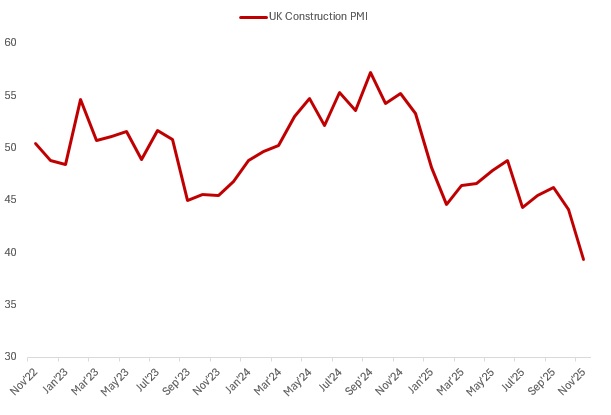
5 December 2025
Jonathan Sparks
Chief Investment Officer, UK, HSBC Private Bank and Premier Wealth
Two poignant reminders this week on why there is unease withing the BoE. Why those within the Monetary Policy Committee were divided on whether to cut rates.
On the one hand, the latest PMI Construction survey was an absolute shocker. By falling to 39.4, this is the lowest level of activity outside of covid, when the industry almost completely shut up shop. Everything is down: employment, new orders, optimism. Costs are rising and the orders aren’t coming in.

On the other hand, the latest year ahead inflation expectations for the BoEs very own Decision Makers Panel survey is stuck at 3.4%. Meanwhile, the 3-year ahead expectations have been trickling higher over the last year and sit at 3.0%. Still a far cry from post-covid levels, but high enough to cast doubt over whether to cut rates.
Wage data is again very conflicting. Public sector wages have accelerated and are growing at an annualised rate of 7.6%, whereas private sector wages are more reflective of the falling number of job vacancies.
Consumer confidence: again, another conflicting story. The headline figure has been moving sideways, and households are actually quite upbeat about their financial position. The problem is they are much gloomier about the economic outlook, and this is causing them to save rather than spend.
When the BoE weighs this up, they see an economy that is stumbling along but not capitulating; inflation that is likely to fall, but is still being propped up by pockets of wage growth and elevated inflation expectations; a fear that areas of clear weakness could eventually steer to UK into a downturn that they can then only belatedly react to.
Now that the budget is behind us, there is a window of hope. Both the construction PMI and more downbeat household confidence are surveys that have been more sensitive to budget uncertainty. Business have parked some investment while waiting to have more clarity from the budget, while households were bracing for tax rises. Just the uncertainty can hold back spending and now that there is more fiscal headroom both business and households can put plan in place for the future.
This is what we will be looking for in the coming months. Will consumer confidence pick up? Will orders in construction turn a corner? Also, as far as the BoE is concerned, will inflation pressures ease enough to lean more into cutting rates, a calm that inner turmoil within the MPC? If these indicators head in the right direction, a more positive investment case could be built around the UK outlook; but if not, then the UK will remain a tricky market to invest in. The next few weeks will be crucial.
This is why, for now, we stay more focused on UK investment grade bonds. These are high quality, so can weather an economic downturn, while also providing a good alternative to cash.

We’re not trying to sell you any products or services, we’re just sharing information. This information isn’t tailored for you. It’s important you consider a range of factors when making investment decisions, and if you need help, speak to a financial adviser.
As with all investments, historical data shouldn’t be taken as an indication of future performance. We can’t be held responsible for any financial decisions you make because of this information. Investing comes with risks, and there’s a chance you might not get back as much as you put in.
This document provides you with information about markets or economic events. We use publicly available information, which we believe is reliable but we haven’t verified the information so we can’t guarantee its accuracy.
This document belongs to HSBC. You shouldn’t copy, store or share any information in it unless you have written permission from us.
We’ll never share this document in a country where it’s illegal. This document is prepared by, or on behalf of, HSBC UK Bank Plc, which is owned by HSBC Holdings plc. HSBC’s corporate address is 1 Centenary Square, Birmingham BI IHQ United Kingdom. HSBC UK is governed by the laws of England and Wales. We’re authorised by the Prudential Regulation Authority (PRA) and regulated by the Financial Conduct Authority (FCA) and the PRA. Our firm reference number is 765112 and our company registration number is 9928412.